#climate variability and change
Explore tagged Tumblr posts
Text
Tea thrives in very specific agro-ecological conditions and in certain environments which, today, are often impacted by climate change.
This study addresses the knowledge gap through a systematic literature review that examines the following question: What are effects of environmental variation related to climate change on tea quality? Given the lack of studies examining long-term effects of climate change on tea quality, we synthesize studies that examine the effects of environmental factors that are shifting with climate change. This review can inform future research by identifying literature gaps and new research questions while serving as a model for literature reviews on climate change effects on crop quality.

Environmental Factors Variably Impact Tea Secondary Metabolites in the Context of Climate Change.
#Environmental Factors Variably#Tea cultivation#Tea production#Climate change#tea quality#agro-ecological conditions
0 notes
Text
"A surprise discovery from the University of Birmingham shows that we may be significantly underestimating the potential of trees to regulate the variables of climate change.
That’s because they found microbes living inside trees’ bark absorb the greenhouse gas methane about as significantly as microbes living in the soil.
It’s long been thought that soil is the only effective terrestrial methane sink, as certain microorganisms use methane as a food source, but similar creatures live under a tree’s layer of bark, meaning that not only do our woody cousins withdraw CO2 from the atmosphere and store it in their roots, but also remove methane as well, about as effectively or perhaps more so than soil.
Methane is a potent greenhouse gas for the few short years it exists in the atmosphere before degrading.
Professor Vincent Gauci of U. Birmingham led the study, published in the journal Nature.
In the study, the researchers investigated upland tropical, temperate, and boreal forest trees. Specifically, they took measurements spanning tropical forests in the Amazon and Panama; temperate broadleaf trees in the UK; and boreal coniferous forests in Sweden.
The methane absorption was strongest in the tropical forests, probably because microbes thrive in the warm wet conditions found there. On average the newly discovered methane absorption adds around 10% to the climate benefit that temperate and tropical trees provide.
By studying methane exchange between the atmosphere and the tree bark at multiple heights, the researchers were able to show that while at soil level the trees were likely to emit a small amount of methane, from a couple of meters up the direction of exchange switches and methane from the atmosphere is consumed.
In addition, the team used laser scanning methods to quantify the overall global forest tree bark surface area, with preliminary calculations indicating that the total global contribution of trees is between 24.6-49.9 Tg (millions of tonnes) of methane. This fills a big gap in understanding the global sources and sinks of methane.
“Tree woody surfaces add a third dimension to the way life on Earth interacts with the atmosphere, and this third dimension is teeming with life, and with surprises,” said co-author Yadvinder Malhi of the University of Oxford."
-via Good News Network, July 31, 2024
#trees#forests#tree bark#methane#global warming#emissions#plant biology#soil#microbes#microbiology#climate news#climate science#good news#hope
902 notes
·
View notes
Text
China’s massive rollout of renewable energy is accelerating, its investments in the sector growing so large that international climate watchdogs now expect the country’s greenhouse-gas emissions to peak years earlier than anticipated—possibly as soon as this year[!!!].
China installed 217 gigawatts worth of solar power last year alone, a 55% increase, according to new government data. That is more than 500 million solar panels and well above the total installed solar capacity of the U.S. [...]
Wind-energy installation additions were 76 gigawatts last year, more than the rest of the world combined. That amounted to more than 20,000 new turbines across the country, including the world’s largest, [...]
The low-carbon capacity additions, which also included hydropower and nuclear, were for the first time large enough that their power output could cover the entire annual increase in Chinese electricity demand [!!!!], analysts say. The dynamic suggests that coal-fired generation—which accounts for 70% of overall emissions for the world’s biggest polluter—is set to decline in the years to come, according to the Paris-based International Energy Agency and Lauri Myllyvirta, the Helsinki-based lead analyst at the Centre for Research on Energy and Clean Air.[...]
Its rapid emissions growth long provided fodder for critics who said Beijing wasn’t committed to fighting climate change or supporting the Paris accord, the landmark climate agreement that calls for governments to attempt to limit warming to 1.5 degrees Celsius over preindustrial temperatures. Now, analysts and officials say Beijing’s efforts are lending momentum to the Paris process, which requires governments to draft new emissions plans every five years.
“An early peak would have a lot of symbolic value and send a signal to the world that we’ve turned a corner," said Jan Ivar Korsbakken, a senior researcher at the Oslo-based Center for International Climate and Environmental Research.
In 2020, Chinese leader Xi Jinping pledged that the country’s emissions would begin falling before 2030 and hit net zero before 2060, part of its plan prepared under the Paris accord. He also said China would have 1,200 gigawatts of total solar- and wind-power capacity by the end of this decade. The country is six years ahead of schedule: China reached 1,050 gigawatts of wind and solar capacity at the end of 2023, and the China Electricity Council forecast last month that capacity would top 1,300 gigawatts by the end of this year.[...]
Transition Zero, a U.K.-based nonprofit that uses satellite images to monitor industrial activity and emissions in China, says the official data are “broadly aligned and consistent" with theirs.[...]
[M]oving China’s timeline for an overall emissions peak forward could shave off around 0.3 to 0.4 degrees Celsius of projected global warming if emissions started to decline next decade, analysts say.[...]
The most certain variable in the equation is the breakneck pace of China’s renewable-energy rollout, which analysts expect will continue to add 200 to 300 gigawatts of new wind and solar capacity a year. The investments in renewable energy have become a major driver of the Chinese economy. The country’s clean-energy spending totaled $890 billion last year, up 40%. [...]
The adoption of electric vehicles is happening so rapidly that analysts say peak gasoline demand in China was already reached last year[!!!].
10 Feb 24
774 notes
·
View notes
Text
New Fear
I have been on tumblr a long time. A looooong time. Far longer than I should have been, really.
And I've been arguing with schmucks about birds being dinosaurs... pretty much that whole time. Folks tend to get angry when a dinosaur blog posts birds, after all. It happens.
And while the game of whack a mole is ancient, it's not unpredictable. Usually, it ends in one of two ways:
the person admits they were wrong, and they back down
the person stops arguing with me and blocks me
I'm okay with either one, really. the former is ideal, the latter at least brings me peace.
Never before this past weekend has someone insisted they were right no matter what I say
And this isn't a coincidence.
Over the past few decades, anti-science sentiment has risen worldwide. I mean you just have to look at the COVID19 pandemic, or general reactions to the problems of climate change.
While of course people who think their opinion matters more than evidence have always existed, they have never been quite this bold before.
The idea that the colloquial definition of dinosaur matters, at all, is a completely new idea and one that has no basis in reality.
And yet, multiple people this past weekend argued exactly that.
And it sounds exceptionally similar to the idea that people could pick and choose things about COVID19 to believe, or the general republican position on science (only things that back up their bigotry are true).
It really seems to reflect a general increase in anti science sentiment and public anti-intellectualism.
Reality isn't actually up for debate. Reality isn't actually subjective. And science is the measure of reality
This isn't the same as the biases of society impacting science and making it worse. Saying "what people think is more important than science" is not the same as saying "science forgot a very important variable / factor / to consider data gained by different cultures / to have a wide variety of perspectives/ etc."
And allowing people to continue to perpetuate and believe in delusions leads directly to the spread of misinformation, leading to more people not understanding reality, and so on
This matters because reality matters. Because the reality of our world is not something we can change or escape. And, in fact, us ignoring the reality of the world - like thinking we can have infinite growth on a finite planet - is directly leading to the destruction of that world (climate change).
I am terrified of the rise of anti-science sentiment. I am terrified of the rise of cherry picking, deciding reality is what you want it to be, ignoring evidence. We see this from purely scientific topics all the way to social justice (how much of racism is ignoring the evidence of a) race being a social construct and b) how much racism impacts people's lives? Almost all of it).
This is bigger than birds being dinosaurs or evolution or climate change. This is about our society going on a deeply disturbing and self-destructive path.
And I really don't know what to do about it.
2K notes
·
View notes
Text
Best News of Last Week - December 11
1. Biden administration to forgive $4.8 billion in student loan debt for 80,300 borrowers

The Biden administration announced on Wednesday that it would forgive an additional $4.8 billion in student loan debt, for 80,300 borrowers.
The relief is a result of the U.S. Department of Education’s fixes to its income-driven repayment plans and Public Service Loan Forgiveness program.
2. Detroit on pace to have lowest homicide rate in 60 years this year

A partnership to reduce Detroit crime is being praised with the City on pace for the fewest homicides in 60 years.
"This is the day we’ve been waiting for, for a long time," said Mayor Mike Duggan. The coalition which includes city and county leaders that Detroit Police Chief James White formed in late 2021 to return the criminal justice system in Detroit and Wayne County to pre-Covid operations.
3. Dog that killed 8 coyotes to protect sheep running for Farm Dog of the Year

Over a year ago, Casper was stacked up against a pack of 11 coyotes, and he overcame them all to protect the livestock at his Decatur home. Now he needs your help.
Casper, the Great Pyrenees livestock guardian dog, needs the public to vote for him to become the American Farm Bureau's "Farm Dog of the Year: People's Choice Pup" contest.
4. Shimmering golden mole thought extinct photographed and filmed over 80 years after last sighting

De Winton's golden mole, last sighted in 1937, has been found alive swimming through sand dunes in South Africa after an extensive search for the elusive species.
5. About 40% of the world's power generation is now renewable

The International Renewable Energy Agency (IRENA) and World Meteorological Organization (WMO) have released their first joint report to strengthen understanding of renewable energy resources and their intricate relationship with climate variability and change.
In 2022 alone, 83% of new capacity was renewable, with solar and wind accounting for most additions. Today, some 40% of power generation globally is renewable, due to rapid deployment in the past decade, according to the report.
6. Jonathan the Tortoise: World’s oldest living land animal celebrates 191st birthday

The world’s oldest living land animal - a Seychelles giant tortoise named Jonathan - has just celebrated his 191st birthday. Jonathan’s estimated 1832 birth year predates the invention of the postal stamp, the telephone, and the photograph.
The iconic creature lived through the US civil war, most of the reign of Queen Victoria, the rise and fall of the Soviet Union, and two world wars.
7. New enzyme allows CRISPR technologies to accurately target almost all human genes

A team of engineers at Duke University have developed a method to broaden the reach of CRISPR technologies. While the original CRISPR system could only target 12.5% of the human genome, the new method expands access to nearly every gene to potentially target and treat a broader range of diseases through genome engineering.
---
That's it for this week :)
This newsletter will always be free. If you liked this post you can support me with a small kofi donation here:
Buy me a coffee ❤️
Also don’t forget to reblog this post with your friends.
908 notes
·
View notes
Text
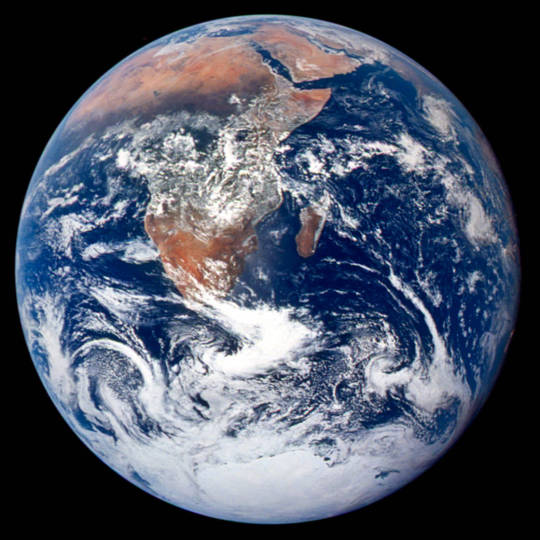
Ways NASA Studies the Ocean
We live on a water planet. The ocean covers a huge part of the Earth's surface – earning it the name Blue Marble.
The ocean is one of Earth’s largest ecosystems and helps moderate Earth’s climate. NASA scientists spend a lot of time studying the ocean and how it is changing as Earth’s climate changes.
In the last few years, NASA has launched an array of missions dedicated to studying this precious part of our planet, with more to come. For World Oceans Month, which starts in June, here are new ways NASA studies the ocean.
youtube
1. Seeing the colors of the ocean 🎨
A new NASA mission called PACE will see Earth’s oceans in more color than ever before. The color of the ocean is determined by the interaction of sunlight with substances or particles present in seawater.
Scheduled to launch in 2024, PACE will help scientists assess ocean health by measuring the distribution of phytoplankton, tiny plants and algae that sustain the marine food web. PACE will also continue measuring key atmospheric variables associated with air quality and Earth's climate.
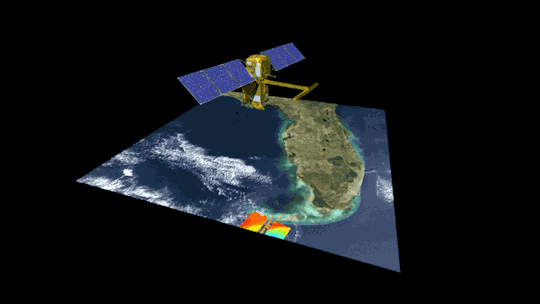
2. Surveying surface water around the globe 💧
The SWOT satellite, launched in late 2022, is studying Earth’s freshwater – from oceans and coasts to rivers, lakes and more – to create the first global survey of Earth’s surface water.
SWOT is able to measure the elevation of water, observing how major bodies of water are changing and detecting ocean features. The data SWOT collects will help scientists assess water resources, track regional sea level changes, monitor changing coastlines, and observe small ocean currents and eddies.
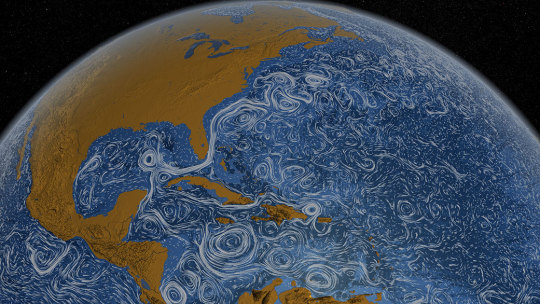
3. Setting sail to understand interactions between the ocean and atmosphere 🚢
With research aircraft, a research ship, and autonomous ocean instruments like gliders, NASA’s S-MODE mission is setting sail to study Earth’s oceans up close. Their goal? To understand ocean whirlpools, eddies and currents.
These swirling ocean features drive the give-and-take of nutrients and energy between the ocean and atmosphere and, ultimately, help shape Earth’s climate.
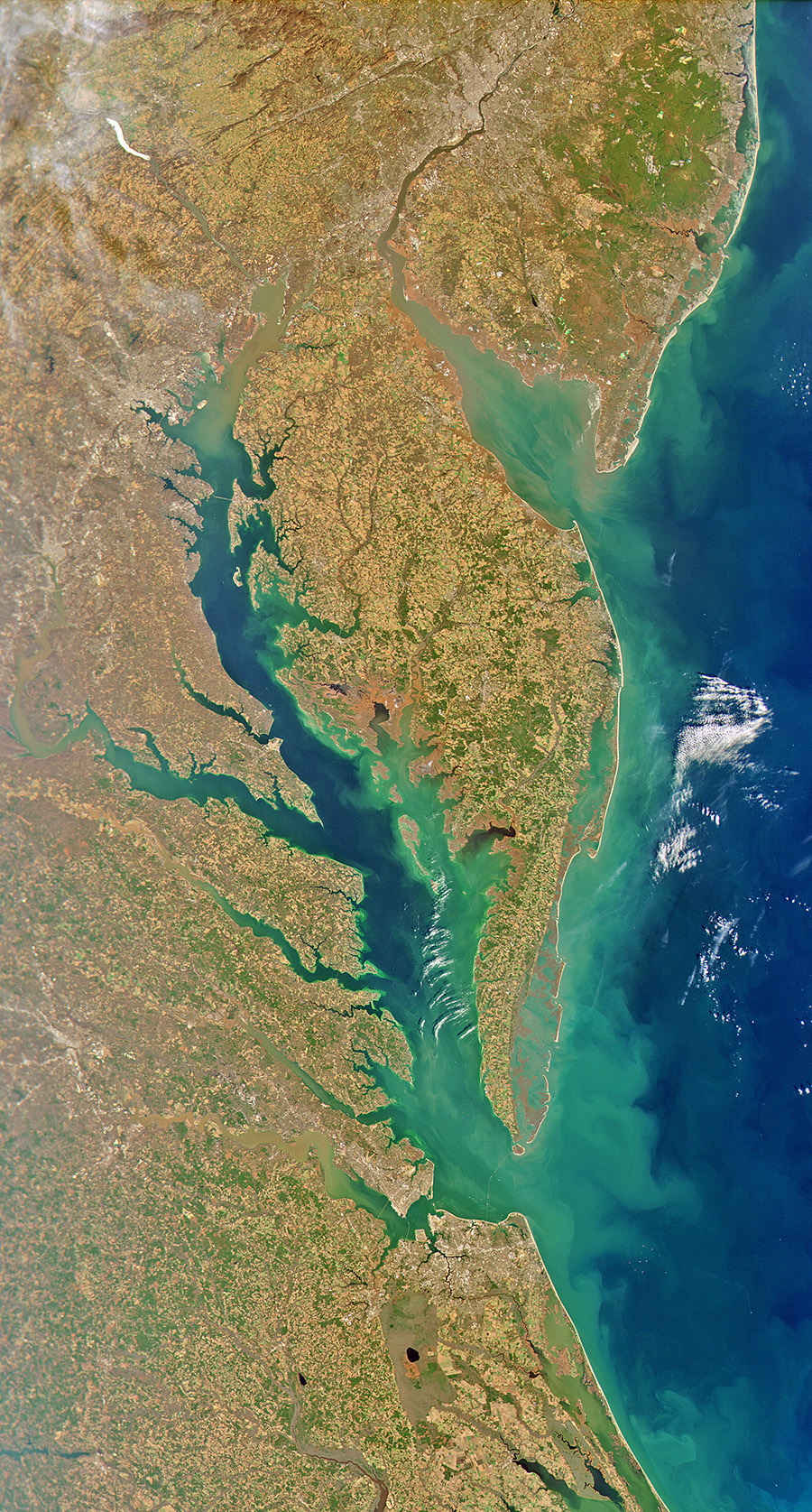
4. Building ocean satellites the size of a shoebox 📦
NASA’s HawkEye instrument collects ocean color data and captures gorgeous images of Earth from its orbit just over 355 miles (575 kilometers) above Earth’s surface. It’s also aboard a tiny satellite measuring just 10cm x 10 cm x 30 cm – about the size of a shoebox!
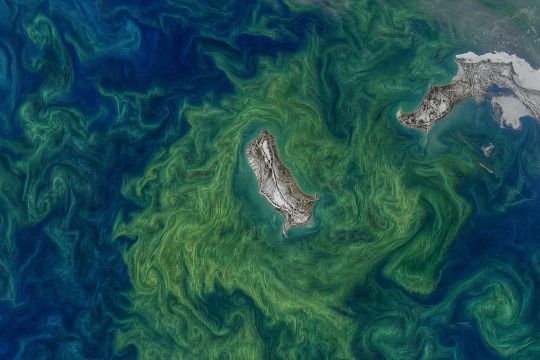
5. Designing new missions to study Earth’s oceans! 🌊
NASA is currently designing a new space-based instrument called GLIMR that will help scientists observe and monitor oceans throughout the Gulf of Mexico, the southeastern U.S. coastline and the Amazon River plume that stretches to the Atlantic Ocean. GLIMR will also provide important information about oil spills, harmful algae blooms, water quality and more to local agencies.
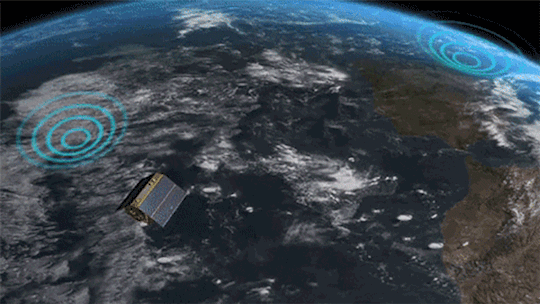
6. Taking the ocean to new heights ⬆️
The U.S.-European Sentinel-6 Michael Freilich satellite is helping researchers measure the height of the ocean - a key component in understanding how Earth’s climate is changing.
This mission, which launched in 2020, has a serious job to do. It’s not only helping meteorologists improve their weather forecasts, but it’s helping researchers understand how climate change is changing Earth’s coastlines in real time.
Make sure to follow us on Tumblr for your regular dose of space!
2K notes
·
View notes
Text
re: Hurricane Helene and Appalachia
I think it's worth mentioning that as climate change intensifies, we will be seeing more and more of this.
Climate change isn't just about rising temperatures and sea levels.
Higher air and water temperatures can and will affect currents and precipitation. While we might not see an increase in the frequency of storms during hurricane season, we will see more tropical storms becoming hurricanes and more hurricanes attaining higher category ratings.
Here is a link to a NASA article giving an overview of the science behind it all, but long story short:
Warmer oceans + more humidity = stronger storms.
That means bigger storm surges (=more flash flooding), higher wind speeds, and the potential for storms to sustain themselves as they move further inland.
I'm speaking from an East Coast U.S. perspective and hurricane season is what I'm most familiar with, but climate change also affects weather patterns in various regions of the world, such as monsoon season (which impacts 40% of the global population according to this article) and wildfire season (1, 2, 3).
Tornadoes are a bit more complicated, mostly because there's still a lot we don't know about them. Meteorologists can give forewarning that a thunderstorm or supercell has the potential for tornado formation, but there's really no way to predict in advance exactly where or when a tornado will form, let alone how intense it might be, how large it will grow, how long it will stay on the ground, or what route it will take. The total yearly count of tornadoes in the U.S. hasn't changed all that much, but tornado season is becoming more variable and outbreaks are getting more frequent and intense. It's hard to say whether or how climate change is causing those changes, but given how climate change is affecting weather in general and extreme weather events specifically, it's not hard to imagine that climate change is a variable when it comes to tornadoes and supercells.
TL;DR -- Weather is weird and there are a million little variables that go into creating extreme weather and if one of those variables changes (e.g. global temperature), the whole system is going to be impacted one way or another. Given the slow response to making the kinds of systemic changes that will truly mitigate climate change, there's going to be an escalating need going forward to advocate for those regions most at risk for extreme weather events, which includes advocating for funding for disaster relief.
138 notes
·
View notes
Text
Apocalyptic squirreling
We're not, like, impaling these quotes like the proverbial shrike or anything, just hoarding them away in a nice stash. A collection of Disco Elysium tidbits about the end of the world compiled by @yekokataa and I, feel free to add!

...starting with the game's earliest teaser trailer.
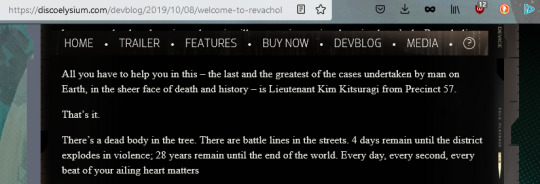
(28 rather than 27 could be its own odd math, there's some miscounting in the text now and then just like there's the occasional typo, or it could follow the fact that the year of canon events was changed at some point. for that matter, the infamous 22 years to the nuke should be 21, like it originally followed that same 28 and wasn't edited - consistently, the variable it flags is ice.andre_hyper_rc_succ_28)

(this is an example of odd math to me, for the record, as it's 365x27 to the day. It could be it's the EXACT count and also that Elysium doesn't have leap years, but I would've expected a less precise number, personally)


:)
Ours has actual six thousand years of history: it spans from its own version of the early Bronze Age (Perikarnassian period) to the early Middle Ages (Franconigerian period), to the Renaissance (Dolorian period), right up to a decade we call “The Seventies”. It’s a world like ours, one that has evolved culturally and technologically over widely varied periods of time. No Truce With the Furies takes place in the modernity of this world.
(source)
Q: How tight is the connection between the book and the game? Is it a Witcher-like situation? KURVITZ: Things in this world are connected to each other like things in our world are connected to each other – not like things are connected to each other in Star Wars. The book and the game share themes and historical developments. The book is set in the early seventies and the game is set in the early fifties. They are connected the way two stories set in our world would be. The fault-lines developing in the fifties are more apparent in the seventies. The situation has worsened, the political climate has shifted, but there is no Skywalker saga. The main story in Elysium is history.
(source)

yes yes we've all seen the nuke convo but let's put it here for completionism's sake

This connection - saying 22 instead of 27, or 28 as the variable reminds us - could seem strange based on game data alone, but it neatly follows the context of the book, which shows us that the bombing of Revachol is one and the same as the material beginning of the end of the world.

This one is also a fun book throwback, from apocalyptic Kurvitz self-insert to apocalyptic Kurvitz self-insert

(being appreciative of that kind of future just nets you a YEEEAGH)

more personally ominous than globally ominous but ominous nonetheless


("we become vapour" being, of course, the planned title of the eventual Elysium tabletop setting rulebook. sigh.)

This one's intriguing, isn't it? With an eye to Le Retour...

Her echoes of the other dialogue options are similarly ominous, for the record.

And we don't know if Nilsen had visions of his own (the man sounds well-acquainted with his Half Light, on behalf of the war crimes, so it's not... entirely out of the question) but we do know that his pocket calculator lap cat second-bestie very much did and could've been his source.


Also a strong book callback, among other things. Remember kids: object permanence!

Harry, all these quotes like this one sound like they would make sense for the actual guy who goes and blows it all up, not you personal-

...ah yes. Ambrosius looms... yeah buddy it sure is solemn AND historical, I'm afraid:

and of course, in closing:

🥲
...for the remaining 276 pages of Elysium tidbits about the end of the world, of course, over here.
218 notes
·
View notes
Text
Where There's Smoke, There's Fire and a Lack of Urgency
Under Lula and Marina Silva, the Minister of the Environment, a greater contrast with Bolsonaro's setbacks was expected; Congress barely reacts to the drought tragedy

With 60% of the territory shrouded in smoke from fires and forest fires, Brazil is facing an environmental crisis no less impactful than the floods in Rio Grande do Sul. However, both the government and society react lethargically to the disaster.
From the beginning of the year until Sunday (8), the country had 165,000 fire hotspots recorded by satellite, 82% of them in the Amazon and the Cerrado. Winds carry the smoke from vegetation burning to the South and Southeast, overloading health services with cases of severe acute respiratory syndrome, risking the lives of children and the elderly.
A day will come when additional deaths from the perfect storm of record fires and drought will be tallied, but this is not necessary to gauge the disaster. Amazonian rivers are drying up, isolating riverside dwellers; airports and ports are closing; classes are being suspended; accidents multiply on roads under reduced visibility.
The exacerbation of climate change under global warming creates challenges that go beyond previous parameters for distinguishing natural variability from threatening anomalies, requiring more decisive action in the face of extreme events.
Continue reading.
#brazil#brazilian politics#politics#environmentalism#environmental justice#brazil forest fires 2024#image description in alt#mod nise da silveira
57 notes
·
View notes
Text
Bryan Black, an associate professor of dendrochronology at the University of Arizona Laboratory of Tree-Ring Research, has been applying the tree-ring dating techniques to so-called “fish rings” to understand how environmental variability is affecting fish growth and productivity over decades.
Continue Reading.
81 notes
·
View notes
Text
A new citizen science initiative is empowering sailors to map marine biodiversity and ocean health in the Pacific, equipping blue-water sailors with the latest technology to gather important data while at sea. The Pacific Ocean is the world’s largest ocean and will provide crucial insights into the effects of climate change and biodiversity loss on the region.
Citizens of the Sea, a charity co-founded by Cawthron Institute (NZ) and New Zealand Geographic, and supported by Live Ocean Foundation, has recruited sailors in the 2024 Pacific Rally to help understand the health and function of the world’s biggest ocean.
On their voyage, the sailors are encouraged to help scientists understand the biodiversity and marine environments in the Pacific by collecting eDNA samples to identify thousands of species from a cup of water, create 3D model of coral reefs using the camera on their mobile phone or build a dataset of environmental variables using information on their instruments.
25 notes
·
View notes
Text
Scientists have developed a new solar-powered system to convert saltwater into fresh drinking water which they say could help reduce dangerous the risk of waterborne diseases like cholera.
Via tests in rural communities, they showed that the process is more than 20% cheaper than traditional methods and can be deployed in rural locations around the globe.
Building on existing processes that convert saline groundwater to freshwater, the researchers from King’s College London, in collaboration with MIT and the Helmholtz Institute for Renewable Energy Systems, created a new system that produced consistent levels of water using solar power, and reported it in a paper published recently in Nature Water.
It works through a process called electrodialysis which separates the salt using a set of specialized membranes that channel salt ions into a stream of brine, leaving the water fresh and drinkable. By flexibly adjusting the voltage and the rate at which salt water flowed through the system, the researchers developed a system that adjusts to variable sunshine while not compromising on the amount of fresh drinking water produced.
Using data first gathered in the village of Chelleru near Hyderabad in India, and then recreating these conditions of the village in New Mexico, the team successfully converted up to 10 cubic meters, or several bathtubs worth of fresh drinking water. This was enough for 3,000 people a day with the process continuing to run regardless of variable solar power caused by cloud coverage and rain.
[Note: Not sure what metric they're using to calculate daily water needs here. Presumably this is drinking water only.]
Dr. Wei He from the Department of Engineering at King’s College London believes the new technology could bring massive benefits to rural communities, not only increasing the supply of drinking water but also bringing health benefits.
“By offering a cheap, eco-friendly alternative that can be operated off the grid, our technology enables communities to tap into alternative water sources (such as deep aquifers or saline water) to address water scarcity and contamination in traditional water supplies,” said He.
“This technology can expand water sources available to communities beyond traditional ones and by providing water from uncontaminated saline sources, may help combat water scarcity or unexpected emergencies when conventional water supplies are disrupted, for example like the recent cholera outbreaks in Zambia.”
In the global rural population, 1.6 billion people face water scarcity, many of whom are reliant on stressed reserves of groundwater lying beneath the Earth’s surface.
However, worldwide 56% of groundwater is saline and unsuitable for consumption. This issue is particularly prevalent in India, where 60% of the land harbors undrinkable saline water. Consequently, there is a pressing need for efficient desalination methods to create fresh drinking water cheaply, and at scale.
Traditional desalination technology has relied either on costly batteries in off-grid systems or a grid system to supply the energy necessary to remove salt from the water. In developing countries’ rural areas, however, grid infrastructure can be unreliable and is largely reliant on fossil fuels...
“By removing the need for a grid system entirely and cutting reliance on battery tech by 92%, our system can provide reliable access to safe drinking water, entirely emission-free, onsite, and at a discount of roughly 22% to the people who need it compared to traditional methods,” He said.
The system also has the potential to be used outside of developing areas, particularly in agriculture where climate change is leading to unstable reserves of fresh water for irrigation.
The team plans to scale up the availability of the technology across India through collaboration with local partners. Beyond this, a team from MIT also plans to create a start-up to commercialize and fund the technology.
“While the US and UK have more stable, diversified grids than most countries, they still rely on fossil fuels. By removing fossil fuels from the equation for energy-hungry sectors like agriculture, we can help accelerate the transition to Net Zero,” He said.
-via Good News Network, April 2, 2024
#water#water scarcity#clean water#saline#desalination#off grid#battery technology#solar power#solar energy#fossil fuels#water shortage#india#hyderabad#new mexico#united states#uk#united kingdom#good news#hope#aquifers
998 notes
·
View notes
Text
affirmation: motherly older woman tells you you're "such a smart girl~" for pointing at how the El Niño Southern Oscillation matches up to this chart of rainfall by year since 1978.
"what a good girl, you're so well behaved. I'm so proud of you for describing the drivers and impacts of climate change and climate variability at different time scales using key climate science concepts❤️❤️❤️"
24 notes
·
View notes
Quote
‘The sea is never pregnant,’ a Wolof proverb goes: You can never predict when it will deliver. You can never predict what it will take, either. The immensity of the ocean has room for every variable – God, genie, climate change, tides – but it bestows and withholds its wealth, shelters and destroys at whim unfathomable to man. To live off the sea is to submit to its vagaries, to endure constantly the tension between desire and defeat.
Anna Badkhen, from her essay, “The Secret Afterlife of Boats”, published in Granta, February 12th 2016
158 notes
·
View notes
Text
Nothing Is True, Everything Is Permitted.
What does this mean? From my limited perspective, it is that objectivity does not exist and we should only make the best, most informed decisions. There is something in Nothing Is True that reminds me of Gramsci's Cultural Hegemony. How much of what we believe has been spoon fed to us? How much of what we believe has been instilled in us and we just take things as given. In the same vain of thought as Mark Fisher's Capitalist Realism, it's hard to imagine new things, especially when we as a collective have been told that this is the either "best way" or the "least worst option". From my understanding, the words Nothing Is True is point out that there are millions of variables unaccounted for and we must constantly think about our perspective and how we operate in a wider society. Dialectical Materialism (from how little i understand so feel free to correct me) is the theory and study of how there are so many moving pieces in the world and how everything changes from interaction with each other. Billions of people, ten billion animals and uncountable insects, these all operate in a system together and it helps understand the world when you look at all of these through the understanding that no man, no individual is an island, no one person or animal operates independantly.
Everything Is Permitted is about the actions we must take to better society and the world. In the face of global collapse, who cares about stockholders and share values? Who cares about the gas that runs your car if you'll be dead from climate change? But i'll also add that i believe that Freedom means responsibility. Freedom means that you *could* do as you please, but that does not remove responsibilities or consequences. Those who view freedom as the ability to persue every want and crave and urge will only find themselves enslaved to every desire. To me, dear reader, freedom is a means. There are no ends except life and persuit of a better world.
#altair#assassin's creed#philosophy#ac origins#communism#altair ibn la'ahad#ezio auditore#bayek of siwa#ezio#socialism
16 notes
·
View notes
Photo

Diversity in Church Architecture in Medieval England
Medieval English churches differed in size and layout. Their original and evolving role(s), financial and material resources, and architectural fashions helped determine variability. However, their look ultimately grew from a constant symbiosis between being a place for worship and practical matters. During the 10th-15th centuries, stone construction became firmly established, and that witnessed a golden era of church building.
Purpose & Resources
Immediate, mundane reasons for diversity were just as for any other buildings – houses, castles, offices – it depended on the purpose for which they were originally built and the financial and material resources available to the initial builders and to later owners who wanted to extend and/or beautify it.
Impoverished communities created basic churches employing the means and materials members of the settlement possessed or could source nearby using their own sweat and skills. Rich sponsors had the wherewithal to envisage and execute the most lavish projects money and authority could buy, transporting materials from far and wide, engaging the leading designers, technology, masons, metalworkers, carpenters, painters, and glaziers of the day.
Basic buildings might be erected as outposts of mother churches/minsters or by individual villages or minor landowners wanting a place, however humble, to express their faith, as a centre for the daily, weekly, and yearly cycles of devotion that dominated and led peoples' lives. They were simple rectangular structures, large enough for maybe 15 to 20 worshippers. The grandest undertakings were sponsored by major royal, aristocratic, or religious order benefactors to produce leading centres of ecclesiastical, administrative, and scholarly influence. Many of the great cathedrals, abbeys, and minsters, like Durham, Lincoln, and Old St Paul's London were wonders of the world at the time they were built, well over 100 meters long, 100 meters high, or more, and tens of meters wide.
Of course, the majority of churches fell in between these extremes. Some might not initially have been conceived on a grand scale, yet over the centuries they grew as patrons and communities responded to changing population sizes and advances in building technology that fed the desire to always have the bigger, better, more beautiful, the latest architectural fashion. In the economic climate of the later Middle Ages, fresh sponsors of church building and extension entered the scene. Newly rich guilds and merchants in many towns employed their wealth to craft ornate chapels or enhance an existing church with which they were associated. From unpretentious origins, many modest buildings thus grew into impressive houses of God – witness Leicestershire's grandest church in Melton Mowbray backed by wool traders' money, and the great wool churches of Norfolk and Suffolk.
Continue reading...
30 notes
·
View notes